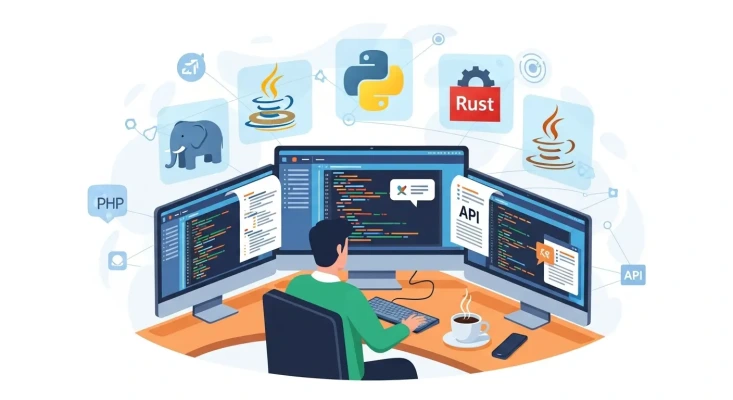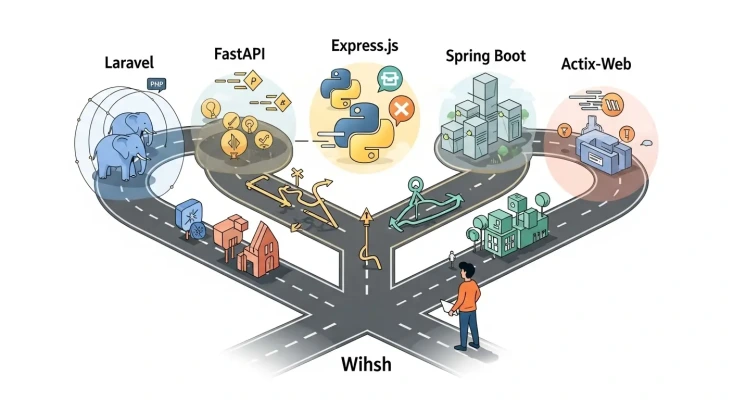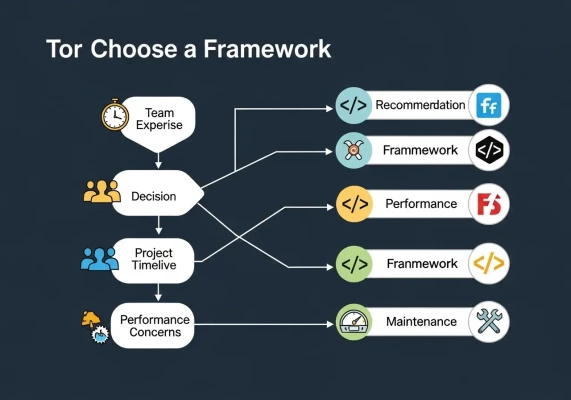Choosing REST API Frameworks in 2025: A Developer's Guide

I've been building APIs for over eight years now, and I've made some spectacular framework choices—and some spectacularly bad ones. Like that time in 2022 when I convinced my team to use a "cutting-edge" framework that had amazing benchmarks but zero community support. Three months later, we were rewriting everything because we couldn't figure out how to implement proper caching. Lesson learned: flashy features don't always translate to real-world success.
After working on dozens of API projects—from tiny side projects that got 50 requests a day to enterprise systems handling millions—I've learned that picking the right framework can literally make or break your development experience. Whether you're pulling all-nighters to ship a startup MVP or carefully architecting microservices for a Fortune 500 company, the framework choice matters way more than you might think.
Here's my completely honest take on the REST API frameworks that are still worth your time in 2025. I'll tell you what I actually use in production, not just what looks good in blog posts.
Table Of Contents
- Laravel - The PHP Workhorse That Actually Works
- FastAPI - Python Finally Gets It Right
- Express.js - The Flexible Classic That Refuses to Die
- Spring Boot - The Enterprise Workhorse (Whether You Like It or Not)
- Actix-Web - When Performance Actually Matters
- Making the Choice: What I Actually Consider
- What Nobody Tells You About Framework Choice
- Why Laravel Still Works in 2025 (And Why That Matters)
- The Framework Trap (And How to Avoid It)
- Bottom Line: Focus on Shipping
Laravel - The PHP Workhorse That Actually Works
I'll be straight with you: Laravel just works. And in 2025, it's become more than a framework—it's like having a reliable teammate who's got your back.
I remember my first Laravel project back in 2019. I was skeptical because, honestly, PHP had a reputation problem. But within a day of playing around with Eloquent relationships and Laravel's routing, I was hooked. There's something deeply satisfying about writing return UserResource::collection(User::with('posts')->paginate()); and knowing it'll just work—with proper pagination, eager loading, and clean JSON output.
What I love about Laravel is how it handles the boring stuff that usually eats up hours of your time. You know those tedious tasks like setting up authentication, implementing rate limiting, or managing background jobs? Laravel has sensible defaults for all of it. I spent a weekend building a side project API that needed user authentication, email verification, and file uploads. With Laravel Sanctum and built-in features, the backend was done by Sunday evening. Try doing that with a bare-bones framework.
But here's what really sold me: the error messages actually help you fix problems. I can't tell you how many times I've spent hours debugging cryptic error messages in other frameworks, only to find it was a simple configuration issue. Laravel's error pages are so detailed that junior developers on my team can often fix issues without asking for help.
For complex applications that need to handle background processing, Laravel's queue system becomes essential. I wrote a detailed guide on managing asynchronous jobs with Laravel queues that covers everything from basic setup to advanced queue management strategies.
What makes it genuinely great:
- Route model binding that eliminates tons of boilerplate code
- API resources that keep your JSON responses consistent across the entire application
- Sanctum for API authentication that doesn't require a PhD to understand
- Eloquent relationships that make complex queries readable
- A package ecosystem that's actually maintained (looking at you, abandoned npm packages)
The reality of using it: Last month, I was brought into a struggling e-commerce project that had been limping along with a custom PHP solution for months. The previous team had spent weeks trying to implement proper API pagination and search functionality. We migrated to Laravel over a weekend, and suddenly everything worked. The frontend team could finally implement infinite scroll without fighting with inconsistent API responses.
When I genuinely recommend it: PHP projects where you need to ship fast without cutting corners. It's particularly powerful when transitioning from monolithic applications to microservices—Laravel makes it easy to extract specific domains into their own APIs without rewriting everything from scratch.
If you're planning to build production-ready Laravel APIs, I've written an in-depth guide covering Laravel API development best practices and security that includes authentication strategies, performance optimization, and security hardening techniques.
The honest downside: If your team is religiously opposed to PHP, you'll have a hard time selling it. Also, Laravel can feel "magical" to developers who prefer explicit configuration over conventions.
FastAPI - Python Finally Gets It Right
FastAPI has seriously impressed me, and I say this as someone who's endured years of Flask blueprints and Django's "everything including the kitchen sink" approach.
I discovered FastAPI while working on a machine learning project where we needed to serve model predictions via API. Our data science team was already using Python, and the idea of not having to translate between languages was appealing. But honestly, I was expecting the usual Python web framework experience—lots of manual wiring and configuration files.
Boy, was I wrong. FastAPI's approach to automatic validation through Pydantic models is genuinely brilliant. Instead of writing validation logic and hoping it catches edge cases, you define your data models once, and FastAPI handles the rest. I remember showing a junior developer how changing a field from int to Optional[int] automatically updated the API documentation and validation—his mind was blown.
The async support isn't just a checkbox feature either. We were building an API that needed to make multiple external service calls per request. With traditional synchronous frameworks, each request would block while waiting for external APIs. FastAPI's async capabilities let us handle hundreds of concurrent requests on a single server instance. Our response times went from 3-4 seconds to under 500ms just by switching frameworks and adding a few async/await keywords.
What genuinely works well:
- Type hints that actually prevent bugs instead of just looking pretty
- Automatic OpenAPI documentation that stays current with your code changes
- Pydantic v2 data validation that's both fast and developer-friendly
- Built-in dependency injection that makes testing straightforward
- Performance that doesn't make you embarrassed when you check monitoring dashboards
Real-world experience: We built a recommendation API for a content platform using FastAPI. The automatic documentation generation meant the frontend team could start integration work immediately—no waiting for us to write API docs that would inevitably get out of sync. When requirements changed (they always do), updating the Pydantic models automatically updated the documentation and validation rules.
Where it shines: Data-heavy APIs where you're already in the Python ecosystem. It's particularly strong for machine learning teams who need to expose models as services, or any project where data validation is critical.
The gotchas: FastAPI assumes you understand Python's async/await patterns. If your team is coming from synchronous Python, there's a learning curve. Also, the ecosystem is newer, so you might occasionally find yourself writing integration code that exists as a library in more mature frameworks.
Express.js - The Flexible Classic That Refuses to Die
Express isn't the shiny new framework everyone's talking about, but it's still here for very good reasons. Sometimes you need a framework that gets completely out of your way and lets you build exactly what your weird requirements demand.
I've got a love-hate relationship with Express. On one hand, it's minimal and unopinionated to a fault—you can build literally anything with it. On the other hand, that flexibility means you're constantly making decisions about project structure, error handling, and middleware ordering that other frameworks handle for you.
But here's the thing: that flexibility has saved my bacon more times than I can count. Like when I needed to build an API that processed webhook payloads in five different formats, each requiring completely different validation logic. Or when a client needed real-time features mixed with REST endpoints, file uploads, and custom authentication that didn't fit any standard pattern. Express just shrugged and let me build whatever I needed.
The ecosystem around Express has matured beautifully over the years. The combination of Express + TypeScript + Prisma creates a development experience that's actually quite pleasant. You get strong typing, excellent database tooling, and the flexibility to handle edge cases without fighting your framework.
What still makes it relevant:
- Complete control over middleware stack and request handling
- Massive ecosystem of battle-tested middleware packages
- Seamless integration with modern frontend frameworks and tools
- TypeScript support that doesn't feel like an afterthought
- Performance that scales well when you know what you're doing
A real project story: I once inherited a legacy API that was built with Express in 2018. The codebase was a mess—inconsistent error handling, no input validation, and a middleware stack that looked like it was assembled by throwing darts at npm. But because it was Express, I could incrementally fix problems without a complete rewrite. Added validation middleware piece by piece, standardized error responses gradually, and improved the codebase over months instead of being forced into a massive migration.
When I still reach for it: Projects with unusual requirements where opinionated frameworks would get in the way. Also great when you're building something that needs to integrate deeply with existing Node.js infrastructure or when you need to optimize specific request handling patterns.
The honest challenges: Express makes you the architect of your own success or failure. Without discipline, Express codebases can become unmaintainable quickly. You'll spend more time making infrastructure decisions that other frameworks make for you, which can slow down initial development.
Spring Boot - The Enterprise Workhorse (Whether You Like It or Not)
If you've spent any time in enterprise environments, you've definitely encountered Spring Boot. And look, I get it—it's not the most exciting framework to talk about at developer meetups. But there's a reason it's absolutely everywhere in banks, insurance companies, healthcare systems, and government agencies.
My relationship with Spring Boot started when I joined a fintech company after years of working with lighter frameworks. My first reaction was honestly overwhelming—so many annotations, so much configuration, such verbose code. Coming from Express, writing a simple REST endpoint felt like I needed three classes and a PhD in Java enterprise patterns.
But after a few months of working with it in production, I started to understand why enterprises love it. Spring Boot isn't designed for rapid prototyping or weekend side projects. It's designed for applications that need to run reliably for years, handle millions of requests, and be maintainable by teams of dozens of developers who might change over time.
The autoconfiguration magic that initially confused me became incredibly valuable. Spring Boot makes assumptions about common enterprise patterns—database connections, security, monitoring, caching—and provides sensible defaults that you can override when needed. When you're building systems that handle real money or sensitive data, having battle-tested defaults is worth the learning curve.
What genuinely works in enterprise contexts:
- Production-ready features like health checks and metrics endpoints from day one
- Dependency injection that actually helps with testing and modularity
- Comprehensive security features that enterprises actually trust
- Excellent tooling for monitoring and troubleshooting production issues
- A massive ecosystem of enterprise integrations
The reality of Spring Boot development: I worked on a payment processing API that needed to handle complex compliance requirements, integrate with multiple banking systems, and provide detailed audit logs. Spring Boot's annotation-driven approach meant we could focus on business logic while the framework handled cross-cutting concerns like transaction management, security, and monitoring. When auditors asked about our error handling and logging practices, we could point to well-documented Spring patterns instead of custom implementations.
Where it genuinely excels: Large organizations where system reliability matters more than development speed. Financial services, healthcare, government—anywhere that "it worked on my machine" isn't an acceptable answer. Also great for teams that prefer explicit configuration over magic behavior.
The honest downsides: Spring Boot has a steep learning curve if you're coming from simpler frameworks. The abstraction layers can make debugging frustrating when things go wrong. And if you're building simple APIs that don't need enterprise features, Spring Boot can feel like using a excavator to plant flowers.
A dose of reality: I've seen many startups choose Spring Boot because it sounds "enterprise-ready," only to struggle with development velocity. Unless you actually need enterprise features or have Java expertise on your team, simpler frameworks often deliver better results for smaller projects.
Actix-Web - When Performance Actually Matters
Actix-Web is what happens when you decide that raw performance is worth learning an entirely new programming language. Built in Rust, it consistently destroys every other framework in performance benchmarks—and I mean destroys in the best possible way.
I'll be completely honest: I was skeptical about Rust for web development for a long time. The syntax looked intimidating, the compile error messages seemed designed to make me feel stupid, and the ecosystem felt too young for serious projects. But then I worked on a project that really, genuinely needed extreme performance.
We were building an API for a real-time trading platform that needed to handle thousands of concurrent connections with sub-millisecond response times. Our initial Python implementation was struggling, and throwing more servers at the problem wasn't economically viable. After weeks of optimization attempts, someone suggested we try Actix-Web.
The learning curve was brutal. I spent my first week fighting with the borrow checker and trying to understand ownership concepts. But once things clicked, the performance results were undeniable. Our API went from handling 500 requests per second with occasional timeouts to handling 50,000 requests per second with consistent sub-10ms response times. Same hardware, completely different performance profile.
What makes it special:
- Performance benchmarks that make other frameworks look slow
- Memory safety guarantees that prevent entire categories of bugs
- Fearless concurrency that actually delivers on the promise
- Zero-cost abstractions that don't sacrifice performance for convenience
The reality check: Unless you're dealing with extreme performance requirements or massive scale, the complexity probably isn't worth it. I've seen teams choose Actix-Web because the benchmarks looked impressive, only to spend months fighting with Rust concepts instead of shipping features.
When it's actually worth considering: High-frequency trading systems, real-time gaming backends, IoT device management at scale, or any situation where hardware costs are a significant portion of your budget and performance directly impacts business metrics.
The honest trade-offs: Development velocity is slower, especially if your team is learning Rust. The ecosystem is smaller, so you'll occasionally need to implement things that exist as libraries in other languages. But if you actually need the performance, these trade-offs become acceptable.
Making the Choice: What I Actually Consider
 Rather than giving you another comparison table with arbitrary star ratings, here's the mental framework I actually use when choosing frameworks for real projects.
Rather than giving you another comparison table with arbitrary star ratings, here's the mental framework I actually use when choosing frameworks for real projects.
Start with your team, not the technology. I learned this the hard way after convincing a team of Python developers to use Go for an API project because the performance looked better on paper. Six months later, we were still struggling with Go idioms while our competitors shipped features faster with frameworks they already knew. The most performant framework is useless if your team can't be productive with it.
Consider your timeline realistically. If you need to ship in 8 weeks, this isn't the time to learn Rust or explore cutting-edge frameworks. I've seen too many projects choose "interesting" technology stacks only to scramble back to familiar tools when deadlines approach. There's a time for exploration and a time for execution.
Think about the next developer. Will the person maintaining this code in two years (who might be you) thank you for this choice? I once inherited a codebase that used three different web frameworks because the original developer wanted to "try different approaches." It was a nightmare to maintain.
Here's my actual decision process:
Choose Laravel when: You're in the PHP ecosystem and need to balance development speed with code quality. It's particularly strong for teams that value convention over configuration and want to focus on business logic rather than infrastructure concerns. Great for content management systems, e-commerce platforms, and most business applications.
Go with FastAPI if: You're already using Python for data processing, machine learning, or scientific computing. The type system and automatic documentation make it excellent for teams that need to collaborate closely between data science and engineering. Perfect for recommendation engines, analytics APIs, and ML model serving.
Pick Express when: You need maximum flexibility or your requirements don't fit standard patterns. Also the right choice if your team has deep JavaScript expertise and you're building something that integrates tightly with Node.js ecosystem tools. Great for real-time applications, custom integration layers, and APIs with unusual business logic.
Consider Spring Boot for: Enterprise environments where operational concerns outweigh development velocity. If you need comprehensive audit logs, complex security requirements, or integration with enterprise systems, Spring Boot's overhead often pays for itself. Essential for financial services, healthcare, and government applications.
Look at Actix-Web only if: Performance is genuinely business-critical and you have Rust expertise (or budget to develop it). Don't choose Rust because benchmarks look impressive—choose it because your business metrics are directly tied to API performance.
What Nobody Tells You About Framework Choice
Here's what I wish someone had told me earlier in my career: the framework choice matters way less than you think it does in the beginning, and way more than you think it does two years later.
Most frameworks can handle typical business requirements just fine. The differences in performance, feature sets, and development velocity often matter less than team familiarity, ecosystem maturity, and long-term maintainability.
But here's where it gets tricky: once you've built a significant application with a framework, switching becomes exponentially harder. That quick Laravel prototype becomes the production system that handles millions of requests. The "temporary" Express API becomes the core integration layer for your entire platform.
Questions I actually ask before committing:
- Can we hire developers who know this framework in our market?
- Will this framework still be actively maintained in three years?
- How easy is it to deploy and monitor applications built with this?
- What happens when we need to integrate with systems we haven't thought of yet?
- How painful will testing be with this choice?
Why Laravel Still Works in 2025 (And Why That Matters)
Despite all the new frameworks that launch every month, Laravel continues to deliver value. It strikes a balance between convention and flexibility that works for real projects with real constraints.
I keep coming back to Laravel not because it's the fastest or most cutting-edge, but because it consistently helps teams ship quality software without fighting the framework. The Laravel ecosystem has grown tremendously—Forge for deployment, Nova for admin interfaces, Horizon for queue monitoring, Telescope for debugging. When you choose Laravel, you're not just getting a framework; you're getting access to a complete development environment.
The Laravel community deserves special mention. The documentation is actually useful (unlike some frameworks where you need to read source code to understand basic concepts). The ecosystem packages are generally well-maintained. And the conventions are sensible enough that developers can jump between Laravel projects without extensive onboarding.
The Framework Trap (And How to Avoid It)
Here's something that took me years to learn: falling in love with frameworks is dangerous. I've seen developers become so attached to specific tools that they try to use them for everything, even when they're clearly the wrong choice.
I was guilty of this myself. After a successful project with FastAPI, I tried to use it for a simple CRUD application that would have been perfect for Laravel. I spent weeks implementing basic features that Laravel provides out of the box, just because I wanted to stick with the "modern" choice.
The best developers I know are framework agnostic. They choose tools based on project requirements, team capabilities, and long-term considerations—not because they want to pad their resume with trendy technologies.
Bottom Line: Focus on Shipping
 The best REST API framework in 2025 is the one that helps your team ship quality software consistently. Performance benchmarks and feature comparisons look impressive in blog posts, but developer productivity and long-term maintainability determine project success.
The best REST API framework in 2025 is the one that helps your team ship quality software consistently. Performance benchmarks and feature comparisons look impressive in blog posts, but developer productivity and long-term maintainability determine project success.
Don't get caught up in the latest trends unless they solve real problems you're actually facing. Sometimes the "boring" choice is the right choice. Sometimes the framework everyone's using is popular for good reasons.
Your users don't care whether your API is built with the newest framework or the most performant language. They care whether it works reliably, responds quickly enough, and provides the functionality they need.
Choose your tools, build great software, and remember that the framework is just the foundation—the real value comes from what you build on top of it.


Add Comment
No comments yet. Be the first to comment!